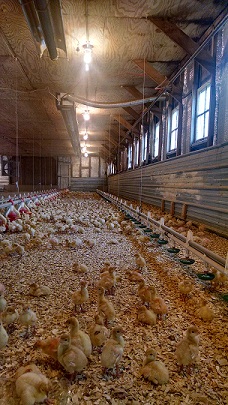|
This is what a brooder barn in a factory-farming turkey operation looks like, in case you were wondering:  On the right side of the picture you can see a row of green drinker cups, height-adjustable so we can raise them as the babies grow. On the left, a row of feeders full of antibiotic-free turkey feed, because it turns out that putting antibiotics into the feed does not, in fact, improve profitability. Along the ceiling you'll notice long gas heaters connected to thermostats set every few meters along the barn, checked obsessively throughout the day to ensure optimal temperatures for our growing babies. The windows along the sides can be opened, cutting back on the humidity in the barns. In addition to these windows, each of our brooder barns is equipped with vent fans that pull stuffy air out of the barn and allow fresh air to flow in. And on the floor, a thick covering of fresh shavings is changed out every five weeks as the flock outgrows their brooder barn and is moved into one of the large growing houses. I share this with you because, while I agree that there are many problems associated with factory farming, the question of animal welfare is almost nonexistent on any operationally sound farm. My family is definitely not at the leading edge of farm technology, nor indeed of animal welfare, yet even we have adopted an antibiotic-free growing regime that includes (I kid you not) the twice-weekly spraying of beneficial microbes in the barns. The idea is to outcompete disease-causing microbes with helpful bacteria and create a healthy growing environment for the turkeys. We are spraying our birds with essentially the same probiotics you can buy in capsules at health food stores, and achieving very good results (also, it is also the only mixture I have ever sprayed from a backpack sprayer that doesn't require any sort of protective gear). Walk into one of these brooder barns, or even one of the large grow-out barns, and you will not be confronted with lung-searing ammonia, nor strong rotten odors from decay. Barn hygiene is essential to a good operation, and we change out the bedding frequently and remove dead birds immediately. Ventilation is essential both for animal health and for optimal growth. Animal crowding, a frequent complaint of animal rights activists, does not generally occur in our industry. With turkeys, if a grower tries to put too many birds in a barn in the mistaken hope of getting more money with less work, he will soon discover that the birds, in their crowd-induced stress, will have cannibalized each other quite brutally, pecking the skin off of each others' heads and plucking the wings from their neighbors' backs, causing high mortality and low-quality meat. I am happy that my farm can provide a positive example of what factory farming actually looks like to the animals being farmed. These birds, at their best, have a sort of unreflective vigor that is both frustrating (like when they chase you up and down the barn in one giant pack, screeching at the top of their register) and fascinating. When they're happy, they respond to everything with aplomb. When they're miserable, they make sure you know. Our job is to make sure they stay as vigorously annoying as possible throughout their lives here. It's what makes them happy. |
About Me:
|
 RSS Feed
RSS Feed
